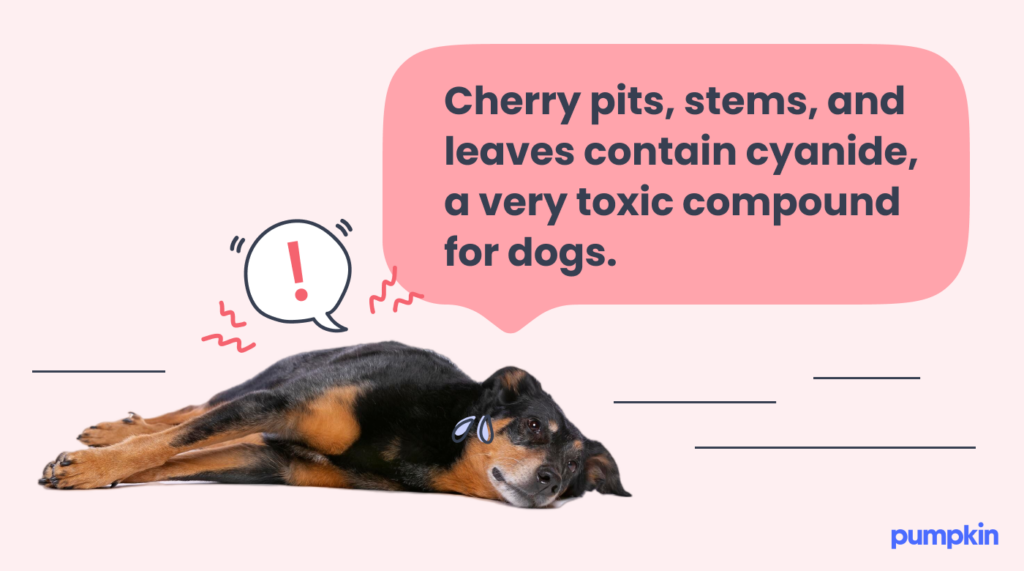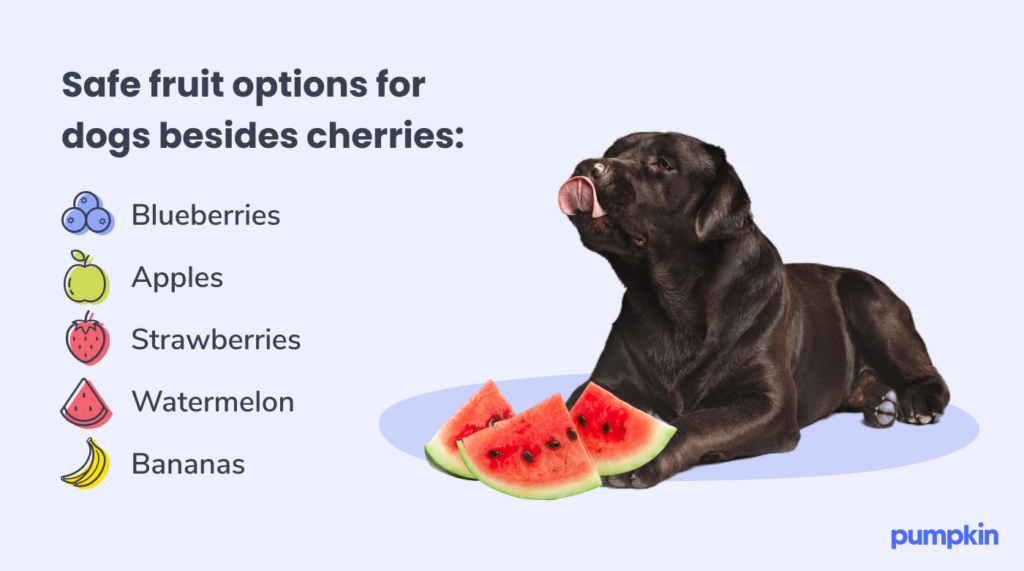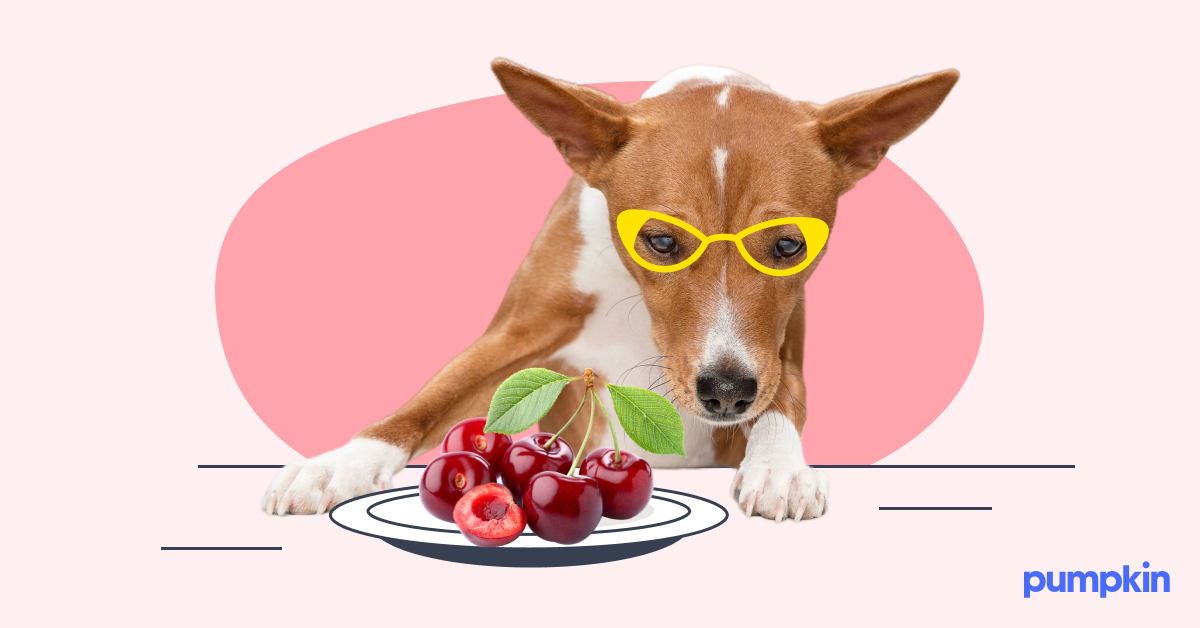Key Points:
- Dogs should not eat cherries, as the pits, stems, and leaves are toxic.
- Cherries are also high in sugar and pose a choking hazard.
- The flesh of the cherry is okay for dogs, but it’s safer to stick with other fruits.
Cherries are a summer favorite for fruit salads, pies, jams, juices, and other delights. They’re full of beneficial nutrients for us humans, but are they safe for our dogs to eat?
Unfortunately, cherries are not safe for dogs. While the flesh of the cherry isn’t toxic, the risks of this fruit outweigh the benefits. And because there are so many other fruits and veggies your pup can eat safely, you should avoid sharing cherries with your dog.
In this guide, you’ll learn what makes cherries harmful for dogs, what to do if your dog accidentally eats a cherry, and our favorite fruit alternatives.
Why aren’t cherries safe for dogs?
The soft flesh (also called the meat) of the cherry isn’t toxic to your dog. However, even though the flesh is technically safe, that doesn’t make cherries a safe bet for dog-friendly snacks.
Here’s why:
- Cherry flesh is high in sugar and can cause weight gain and dental problems
- Cherry pits, stems, and leaves contain cyanide, which is toxic for dogs
- Cherries are choking hazards due to their size, shape, and pits
- Cherry pits can become lodged in a dog’s throat or internal organs and cause damage
So, we believe the risks of feeding cherries to dogs outweigh any possible value. Now, let’s break down these risks in a little more detail.
Risks of feeding cherries to dogs
If your dog does manage to gobble up a cherry, your best bet would be to contact your vet and watch your pet for any signs of distress. You may also want to know a little more about the possible health risks.
Cyanide poisoning
Cyanide is a very toxic compound found in the pits, stems, and leaves of stone fruits. The good news is that one or two cherries probably won’t cause a life-threatening situation, even for a very small dog.

According to the Pet Poison Helpline:
“If your dog manages to sink his teeth into a whole cherry when you are not looking, it’s not the end of the world. One cherry will not cause cyanide poisoning. But you should still be on the lookout for symptoms of intestinal blockage such as vomiting, little to no appetite, and constipation. Symptoms of cyanide poisoning may be seen in dogs that have consumed a large amount of cherries and broken open the seed within the pit of the cherry.”
Pet Pro Tip: If you have a dog that is prone to ‘snacksidents’ – you should consider getting a dog insurance plan as soon as possible. It can help you afford the best care in the future by covering eligible vet bills for digestive illnesses, toxic ingestion, and more.
Symptoms of cyanide poisoning can come 20 to 45 minutes after ingestion. Symptoms to watch for include:
- Panting or hyperventilation
- Bright red gums
- Dilated pupils
- Abnormal heartbeat
- Convulsions or seizures
- Collapse
- Death
If your dog got into the cherry bowl and isn’t feeling well, contact your vet immediately. In extreme cases, the vet may want to induce vomiting to prevent cyanide toxicity.
Intestinal upset
Cherry ingestion can also cause intestinal upset. Watch for signs of intestinal upset for 24 hours after eating cherries. They include:
- Vomiting
- Decreased appetite
- Diarrhea
Contact your veterinarian if your pup is experiencing these uncomfortable symptoms after eating cherries.
Choking and esophageal tearing
Both the cherry pits and whole cherries are a choking hazard. Even if the fruit doesn’t get stuck in the throat and block the airway, the pit can damage or tear the esophagus lining on the way down.
Signs of esophagus damage include:
- Lethargy
- Vomiting
- Gagging
- Refusal to eat
These are emergencies that require urgent veterinary care.
Intestinal blockages
Ingesting the pit can also cause gastrointestinal blockage. This can be life-threatening and require surgery.
Signs of an intestinal blockage include:
- Vomiting
- Constipation
- Decreased appetite
- Decreased fecal production
- Swollen abdomen
- Painful abdomen
If your dog has chomped down some cherries, you need to watch for these symptoms. They can appear up to 24 hours after ingestion.
Cherry allergies
Though rare, cherry allergies do exist. The symptoms of cherry allergies in dogs are the same as those of other food allergies:
- Abdominal pain
- Gas
- Itchy skin
- Vomiting
- Diarrhea
- Hives
Always monitor your pup after feeding them new human foods to watch for signs of an allergic reaction. If your dog is experiencing these symptoms, you know who to call.
Are there any benefits of cherries for dogs?
All cherry varieties contain vitamins A and C, fiber, magnesium, and some powerful antioxidants. Studies show that the nutrients in this fruit help with blood sugar control, muscle regeneration after exercise, and reducing hypertension. These are significant benefits for humans. But the benefits of cherries for dogs are very minimal.
Cherries also contain a lot of sugar. One cup carries 22 grams of carbohydrates — most of them being glucose or natural sugars. For a human, that’s not too bad, but for a dog, it’s too much and can potentially lead to an upset stomach and weight gain.
Even if you painstakingly removed the flesh of the cherry from the pits, your dog would still need to consume an excessively large quantity of cherries to reap any benefits. So, while you can find ways to prepare cherries for dogs online, we don’t recommend it.
Safer alternatives to cherries
Why run the risks when there are so many other yummy, safe, and healthy fruit options to get your pup’s tail wagging?

The best fruit alternatives to cherries for dogs are:
Blueberries: These berries are jam-packed with antioxidants, vitamins, and minerals that boost your pup’s immune system and reduce inflammation. They’re high in fiber, which helps promote smooth digestion, and low in calories, making blueberries great for training treats.
Apples: This is another fiber-forward fruit that’s great for doggy digestion. They also contain calcium and potassium, which contribute to healthy bones and energetic muscles. Make sure to practice moderation when it comes to apples as too much fiber can cause an upset stomach.
Strawberries: A low-calorie snack, strawberries are also packed with vitamin C, fiber, and antioxidants. Make sure to cut them into small pieces and remove the stem before sharing.
Watermelon: Watermelon is mostly water, making it a hydrating snack for your dog. The flesh is the safest bet, so make sure that the seeds and the rind are removed. This fruit is particularly high in sugar, meaning moderation is key.
Bananas: This vitamin-packed fruit is the perfect treat to mash into a KONG toy or other dog food puzzles. They’re a great source of potassium, which supports your dog’s muscles and heart health. Bananas also offer nutrients like magnesium, vitamin B6, and vitamin C. They contain high levels of sugar, so share sparingly.
If you’re looking for healthy alternatives that are low in sugar, you have plenty of options in the veggie kingdom. Some of our favorite low-sugar alternatives for treats include carrots, green beans, broccoli, and even cheese.
Always speak with your vet whenever you consider adding new food to your dog’s normal diet. Your vet knows your dog and will recommend the appropriate amounts for their health needs.
Final verdict: Can dogs have cherries?
If your dog sneaks a cherry off the counter, you don’t need to immediately call the pet poison hotline. Still, because these fruits pose a high risk for pups, you should keep the cherries out of your dog’s reach and save them for yourself. Luckily, there are lots of fresh fruits and vegetables that are safe, so your dog isn’t missing out on too much.
As a devoted pet parent, you know that even the most well-behaved dogs can sneak food sometimes. Be more prepared for life’s little accidents with a dog insurance plan. A Pumpkin Pet Insurance plan can help you afford treatment by paying you back for a portion of eligible vet bills in the future.
FAQs
- https://www.verywellfit.com/cherries-nutrition-facts-calories-and-their-health-benefits-4110123
- https://www.petobesityprevention.org/pet-caloric-needs/
- https://www.intechopen.com/chapters/52207
- https://www.petpoisonhelpline.com/pet-tips/my-dog-ate-a-cherry-pit-what-do-i-do/
- https://www.healthline.com/health/allergic-to-cherries#introduction




